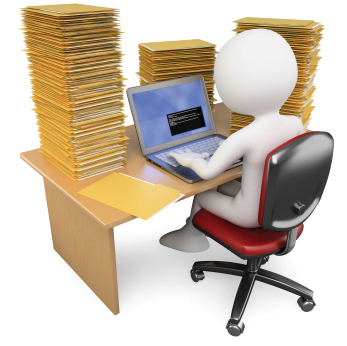
Back up your client files and test your backup periodically. Your backup method will depend on how you keep client files. Some lawyers are paper only, while others are nearly totally electronic. The vast majority is a blend of both. Backup methods favor the lawyer who digitizes data. Lawyers should consider at least digitizing active files.
If not digitizing complete files, identify vital client records and other data that are essential for your business to continue operating. Use a small desktop scanner to scan these documents, and store copies off-site. At the very least, if you are storing paper files in your office, put them in a file cabinet away from areas that potentially could suffer water damage.
There are several easy electronic backup methods, and most are quite easy and inexpensive to do.
The top methods used by lawyers are the following:
Simple External Hard Drive
Favored by the solo and small firm practitioner, this method is simple to use, easy to carry and inexpensive. A disadvantage is that if the device is left at the office and/or the lawyer is prevented from getting to the office, the backup won’t be available. Additionally, lawyers relying on this option often depend on only themselves to remember to do the backing up.
Offsite Storage
Many large firms back data on tapes and then store them securely offsite in a safe place like a bank, storage facility, or firm administrator’s home. A disadvantage is that backed up data kept offsite is not always current.
Online Cloud Storage
An increasing popular method, secure cloud storage providers offer cost-effective backup, either in real time or at set times that you choose (e.g., at the end of the day or twice a day). A good provider will have planned internally for their own disaster by making sure that they have multiple storage sites for their customer’s data – all maximizing your being able to get at your data when you need it. Research your provider before choosing. These services are very easy to use and backup can be scheduled so that it need not depend your remembering to do so. Further, you can access your data anywhere there is internet access. Most cloud providers offer this as a subscription service with cost depending on the amount of data stored. (Carbonite, Mozy are two examples of online data storage providers
Personal or Private Cloud
A relatively new technology, lawyers not wanting a online cloud arrangement can create relatively inexpensively their own cloud. If you share files, work remotely often, and do not have a server for your firm, this could be a relatively inexpensive way to set up remote file storage, sync, and sharing. Such a device would allow you to access your documents from any device and collaborate with clients and colleagues while staying in control of your data. (Transporter is an example. Go here for a comprehensive review.).
Other Methods
Data can also be backed up to a network server, tape and even USB thumb drives and CDs. These methods are inexpensive and very easy to implement. A disadvantage is that these items are fragile, easily lost, and depend largely on your remembering to do the backup. Keep in mind that a disaster may cause you to move around frequently, and risk damaging or losing these items.
Optimally, lawyers are storing and encrypting securely their client data and files, online and offline, in many different ways, and backing up in real time or at least once a day.
Ensure that your backup method is secure. Consider whether encrypting the data will be useful to you.